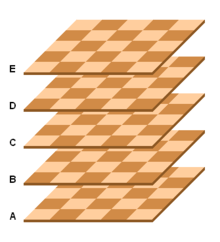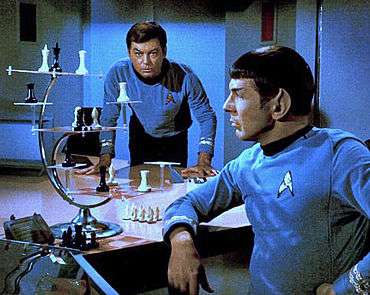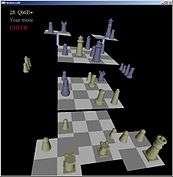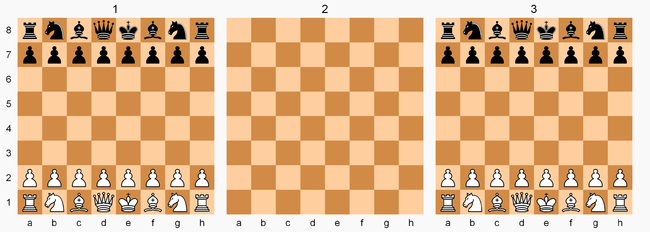Three-dimensional chess

the most popular 3-D board amongst inventors, and at the same time the most mentally indigestible for the players [...] Less demanding on spatial vision, and hence more practical, are those games confined to three 8×8 boards and games with boards smaller than 8×8.[2]
Three-dimensional chess (or 3D chess) refers to any of various chess variants that use multiple boards at different levels, allowing the chess pieces to move in three physical dimensions. Three-dimensional variants have existed since the late 19th century, one of the oldest being Raumschach (German for "Space chess"), invented in 1907 by Dr. Ferdinand Maack and considered the classic 3D game.[3] Maack founded a Raumschach club in Hamburg in 1919, which remained active until World War II.
Chapter 25 of Pritchard's The Classified Encyclopedia of Chess Variants discusses games using boards with three or more dimensions and contains some 50 such variations. Chapter 11 covers variants using multiple boards normally set side by side: "Such games can also be considered as examples of three-dimensional chess"—Beasley.[4]
Raumschach
The inventor contended that for chess to be more like modern warfare, attack should be possible not only from a two-dimensional plane but also from above (aerial) and below (underwater). Maack's original formulation was for an 8×8×8 board, but after experimenting with smaller boards eventually settled on 5×5×5 as best. Other obvious differences from standard chess include two additional pawns per player, and a special piece (two per player) named unicorn.
The board
The Raumschach 3D board can be thought of as a cube sliced into five equal spaces across each of its three major coordinal planes. This sectioning yields a 5×5×5 (125-cube) gamespace. The cubes (usually represented by squares and often called cells) alternate in color in all three dimensions.

The horizontal levels are denoted by capital letters A through E. Ranks and files of a level are denoted using algebraic notation. White starts on the A and B levels and Black starts on E and D.
Rules
|
|
|
| |||||||||||||||||||||||||||||||||||||||||||||||||||||||||||||||||||||||||||
|
|
| ||||||||||||||||||||||||||||||||||||||||||||||||||||||||||||||||||||||||||||
| Raumschach starting position.[5] White's pawn on Bd2 can move to cells with a white dot and capture on cells marked "×". Black's unicorn on Dd5 can move to cells with a black dot or capture the white pawn on Aa2. | |||||||||||||||||||||||||||||||||||||||||||||||||||||||||||||||||||||||||||||
White moves first. The game objective, as in standard chess, is checkmate. Rooks, bishops, and knights move as they do in chess in any given plane.
- A rook moves through the six faces of a cube in any rank, file, or column.
- A bishop moves through the twelve edges of a cube.
- A knight makes a (0,1,2) leap (the same effect as one step as a rook followed by one step as a bishop in the same outward direction) enabling it to control 24 different cells from the board's center.
- A unicorn moves in a manner special to a 3D space (i.e. triagonal movement) through the corners of a cube, any number of steps in a straight line.[lower-alpha 1]
- The queen combines the moves of a rook, bishop, and unicorn.[lower-alpha 2]
- The king moves the same as the queen but one step at a time.
- A pawn, as in chess, moves and captures always forward toward the promotion rank (rank E5 for White, rank A1 for Black). This includes moving one step directly upward (for White) or downward (for Black), and capturing one step diagonally upward (White) or diagonally downward (Black), through a front or side cube edge. In Raumschach there is no pawn initial two-step move (and consequently no capturing en passant), and no castling.
Star Trek Tri-Dimensional Chess

Probably the most familiar 3D chess variant to the general public is the game of Tri-Dimensional Chess (or Tri-D Chess), which can be seen in many Star Trek TV episodes and movies, starting with the original series (TOS) and proceeding in updated forms throughout the subsequent movies and spinoff series.[6][lower-alpha 3]
The original Star Trek prop was crafted using boards from 3D Checkers and 3D Tic-Tac-Toe sets available in stores at the time (games also seen in TOS episodes) and adding chess pieces from the futuristic-looking Classic chess set designed by Peter Ganine in 1961.[9] The design retained the 64 squares of a traditional chessboard, but distributed them onto separate platforms in a hierarchy of spatial levels, suggesting to audiences how chess adapted to a future predominated by space travel. Rules for the game were never invented within the series[10] – in fact, the boards are sometimes not even aligned consistently from one scene to the next within a single episode.
The Tri-D chessboard was further realized by its inclusion in the Star Trek Star Fleet Technical Manual by Franz Joseph, who created starting positions for the pieces and short, additional rules.
Rules development
The complete Standard Rules for the game were originally developed in 1976 by Andrew Bartmess (with encouragement from Joseph) and were subsequently expanded by him into a commercially available booklet.[11] A free summary in English of the Standard Rules is contained on Charles Roth's website, including omissions and ambiguities regarding piece moves across the four Tri-D gameboard 2×2 attack boards.
A complete set of tournament rules for Tri-Dimensional Chess written by Jens Meder is available on his website. Meder's rules are based on FIDE's rules more than Andrew Bartmess' Standard Rules, with some deviations too. A repository of Tournament Rules games can be found on the website of Michael Klein.
Board details
Plans for constructing a Tri-D chessboard can be found on The Chess Variant Pages, as well as in Bartmess' Tri-D Chess Rules. Details for building a travel-size board are included on Meder's website.
Software
There is software for playing Tri-D Chess. Parmen is a Windows application written by Doug Keenan and available free on his website. A free Android version of Tri D Chess is offered by AwfSoft.
Millennium 3D Chess
Millennium 3D Chess, created by William L. D'Agostino in 2001, employs three stacked 8×8 boards.[12] The inventor describes his objective as "extending the traditional chess game into a multilevel environment without distorting the basic game."
In popular culture
- The 1966 Batman episode "The Purr-fect Crime" has Bruce Wayne and Dick Grayson playing a four-level chess variant.
- On the TV show The Big Bang Theory, characters Leonard and Sheldon can be seen playing Tri-D chess in the beginning of Episode 11 in Season 1. Sheldon and Penny also play in "The Hofstadter Insufficiency".
- A three-dimensional chess variant may be seen in the Blake's 7 fourth-season episode "Games".
- A non-Star Trek type of three-dimensial chess set is used as a recurring prop in the lounge of the SHADO Moonbase in the British TV series UFO.
- A space-themed version of three-dimensional chess is played by the titular character in Robert A. Heinlein's 1953 novel Starman Jones.
- Four-dimensional chess is played in Arkady and Boris Strugatsky's 1961 science fiction collection Noon: 22nd Century.
- The game is parodied in episodes of Futurama.
- In the computer game Unreal 2, Aida, one of the main heroes, is called an international 3D chess-master. A board is present in her quarters, identical in appearance to a Star Trek board.
- In the Recess episode "Big Brother Chad", Vince's big brother Chad beats himself in 3D chess.
- In a 2013 Audi commercial, Leonard Nimoy and Zachary Quinto are seen playing three-dimensional chess on iPads.
- Three Dimensional Chess is mentioned as being played by the Legion of Super-Heroes in Superboy and the Legion of Super-Heroes #236.
- In part 3 of the Doctor Who serial "Frontier In Space", prisoners are seen playing three-dimensional chess.
- In Zoey 101, the boys often play this game.
- In The Lego Movie, after Batman's very short travel on the Star Wars Millennium Falcon (equipped with a Dejarik table), Batman suggests Han Solo, Chewbacca, Lando Calrissian and C-3PO play three-dimensional chess.
- The game can be seen being played in the latest Star Trek videogame.
See also
- Alice Chess—two adjacent 8×8 boards[lower-alpha 4]
- Cubic Chess—a 6×6×6 variant
- Dragonchess—three stacked 8×12 boards, a fantasy variant
- Flying Chess—two adjacent 8×8 boards
- Parallel Worlds Chess—an 8×8×3 variant with two armies per player
- Space Shogi—a 9×9×9 shogi variant
References
Notes
- ↑ Thus each unicorn can reach a total of 30 cells of the 125-cell gamespace; each player's pair, 60.
- ↑ Thus giving the queen a total of 26 different directions to move (6 faces plus 12 edges plus 8 corners).
- ↑ There is some discussion whether this game should be called "Tri-Dimensional Chess" as in the Star Trek Star Fleet Technical Manual[7] or "Three-Dimensional Chess" as in The Star Trek Encyclopedia[8] and as on Memory Alpha.
- ↑ "Alice Chess, a well-considered variant, may also be classified as a 3-D game." (Pritchard 1994:305). "In a sense, it is a three-dimensional game, since the board can be thought of as measuring 8×8×2 (in squares)." (Schmittberger 1992:197).
Citations
- ↑ Dickins (1971), p. 16.
- ↑ Pritchard (1994), p. 305.
- ↑ Pritchard (2007), p. 229.
- ↑ Pritchard (2007), p. 93.
- ↑ Dickins (1971), p. 17.
- ↑ Pritchard (2007), p. 226.
- ↑ Schnaubelt (1975), p. T0:03:98:3x.
- ↑ Okuda (1997), p. 342.
- ↑ "Vintage Chessmen by Peter Ganine". Dansk the Night Away. 12 October 2011. Retrieved 2 June 2014.
- ↑ Okuda (1997), p. 509.
- ↑ Bartmess, Andrew (2005). The Federation Standard Tri-D Chess Rules (Revision 5.0 ed.).
- ↑ Pritchard (2007), p. 227.
Bibliography
- Dickins, Anthony (1971) [corrected repub. of 1969 2nd ed., The Q Press, Richmond, Surrey, England]. A Guide to Fairy Chess. New York: Dover Publications Inc. ISBN 0-486-22687-5.
- Okuda, Denise; Okuda, Michael; Mirek, Debbie (1997). The Star Trek Encyclopedia. Pocket Books. ISBN 0-671-53607-9.
- Pritchard, D. B. (1994). The Encyclopedia of Chess Variants. Games & Puzzles Publications. ISBN 0-9524142-0-1.
- Pritchard, D. B. (2007). Beasley, John, ed. The Classified Encyclopedia of Chess Variants. John Beasley. ISBN 978-0-9555168-0-1.
- Schmittberger, R. Wayne (1992). "3D Chess Sets". New Rules for Classic Games. John Wiley & Sons Inc. pp. 103–07. ISBN 978-0471536215.
- Schnaubelt, Franz Joseph (1975). Star Trek Star Fleet Technical Manual. Ballantine Books. ISBN 0-345-34074-4.
Further reading
- Hooper, David; Whyld, Kenneth (1987). "Three-dimensional chess". The Oxford Companion to Chess. Oxford University Press. pp. 351–52. ISBN 0-19-281986-0.
External links
Raumschach
- "Raumschach" by Bruce Balden and Hans Bodlaender, The Chess Variant Pages
- "3-D Chess FAQ File" by David Moeser, The Chess Variant Pages
- Raumschach at BoardGameGeek
- Raumschach a simple program by Ed Friedlander (Java)
- Jocly.com
Star Trek Tri-D
- "3D Chess from Star Trek" by Hans Bodlaender, The Chess Variant Pages
- Tridimensional Chess Rules Andrew Bartmess' commercial site; history of Standard Rules
- Star Trek 3-D Chess Rules Charles Roth's site; free summary of Standard Rules
- 3D-chess site of Jens Meder Tri-D Chess Tournament Rules, boards, and more
- 3DChess Michael Klein's site; Tournament Rules game library and more
- PARMEN Doug Keenan's site; free Tri-D Chess for Windows, supports Standard and Tournament rulesets
- Three-dimensional chess at Memory Alpha (a Star Trek wiki)
- 3-D Chess at BoardGameGeek
- Tri-D Chess Tracker Tri-Dimensional Chess Tracker; web-based Perl program
- Tri D Chess Free Tri D Chess for Android

